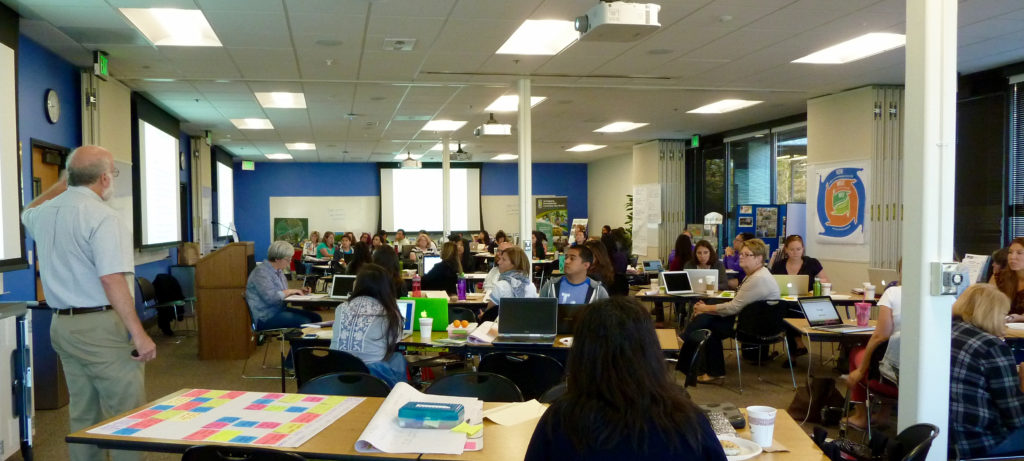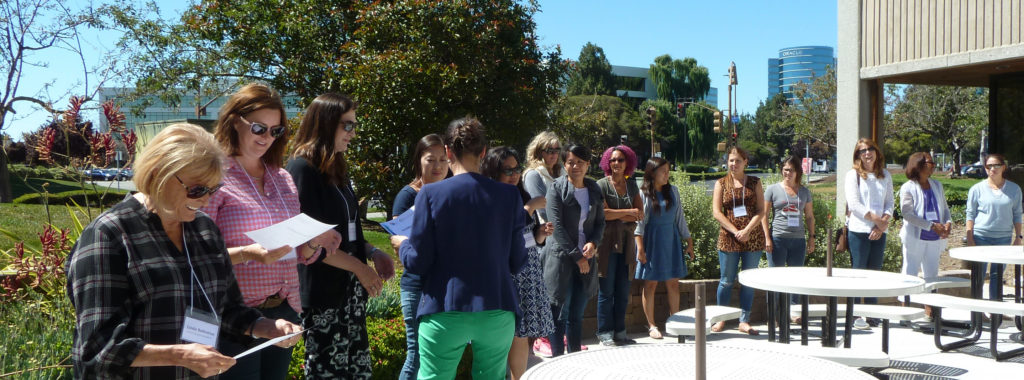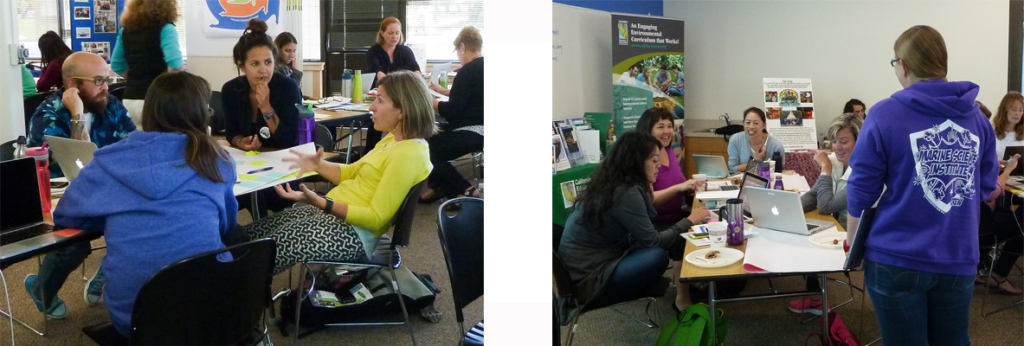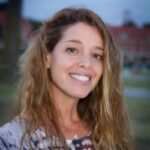Last week Ten Strands and the San Mateo County Office of Education—STEM Center hosted the second iteration of the San Mateo Environmental Learning Collaborative (SM ELC), a professional learning workshop for San Mateo county teachers. The SM ELC brought together area nonformal environmental education partners, curriculum experts from the State Education and Environment Roundtable (SEER), teacher trainers from CalRecycle’s Office of Education and the Environment, and 50 K–12 teachers to learn and explore how to use project-based learning and the environment to meet Next Generation Science Standards (NGSS) in their classrooms.
If you’re a regular reader of Ten Strands’ blog, you may remember last year’s ELC . For this year’s teacher institute we incorporated lessons learned and built on successes to expand the scope and deepen collaborative partnerships to give teachers the tools to create units of study for their classrooms.

Last year, the STEM Center graciously hosted the institutes—this year it was a full partner in every step of the process. Rebecca Vyduna (STEM Director) and Doron Markus (Science and Engineering Coordinator) brought their leadership and expertise in project-based learning (PBL) and NGSS to the planning table and to the institute. The addition of PBL was an exciting new component of the ELC that will further increase student engagement, critical thinking and science skills, and student-centered learning.
“I will definitely want to start implementing more NGSS now that I understand them a little more. I also want to include more PBL into my science curriculum since there is a lot to work from and it’s the best way to spark kids’ creativity.” ~2016 SM ELC Teacher
This year’s institute brought together all of the nonformal providers from last year’s ELC (Marine Science Institute, Project WET, Project Learning Tree, Pie Ranch, Hidden Villa, and RecycleWorks), and we were fortunate to welcome two new partners to the team, CuriOdyssey and Vida Verde. Last year, all of the provider partners put in the time and effort to look at their programs and curriculum and created NGSS alignments for teachers. Having that completed and under their belts, this year the provider partners expanded their roles at the institute and
provided teachers some hands-on time with a sampling of what they offer both in classrooms and at their sites. This was a really effective and engaging way for teachers to see how the “three dimensional learning” of
NGSS can be understood through environment-based experiences. It was also a nice way to break up the day’s events by getting friendly with some marine animals and making a delicious batch of 30-minute goat cheese!

“I thought the nonformal providers were an integral part of the workshop and NGSS. They brought the DCIs and EP&Cs to life in a way that relates to students at all levels.”~2016 SM ELC Teacher
Dr. Gerald Lieberman and Grace Lieberman (SEER) were on hand again this year to lead the teachers through the sometimes difficult alphabet soup of NGSS, and to introduce and integrate California’s Environmental Principles and Concepts (EP&Cs) as the teachers began to understand how to shape their ideas into standards-aligned units of study for implementation this fall.
“I will be using the EP&Cs concepts, DCIs and SEPs to develop and further enhance my lessons, and experiences for students.”~2016 SM ELC Teacher
We were also fortunate to have Julie DiMaio and Debi Knecht, two of last year’s participants, return both as a participants and mentors for this year’s new ELC teachers. If you haven’t read Julie’s blog post about her experience at the 2015 institute and implementation of her unit of study at Lomita Park Elementary, take a moment to check it out; it’s inspirational and a great glimpse into why this type of professional learning is so important.
As you can see from the many quotes we included in this post, the feedback from this year’s teachers at the close of the institute is equally informative and speaks to how collaboration between stakeholder groups (county offices of education, nonformal education providers, state agencies, and community partners) serves teachers and enables them to better support student learning and success.
“This was a helpful, in-depth institute with a lot of valuable information, quality work time, and access to a variety of education partners.”~2016 SM ELC Teacher
Surveys completed by teachers at the end of the institute highlight how this type of professional learning is having a significant impact. Coming into the institute, 62% of the attendees reported a “low to very low” level of comfort with NGSS. Post-institute 92% reported their comfort with NGSS as “moderate to very high”.
“I now have such a clearer understanding of NGSS that I am confident that I will be able to integrate the concepts into many lessons throughout the week.”~2016 SM ELC Teacher
At the start of the institute 78% of the attendees described their comfort with California’s EP&Cs as “low to very low”. By the final day 84% had a “moderate to very high” level of comfort with the EP&Cs.
“(A highlight was) learning about the EP&Cs because previous to this workshop, I did not know they existed. It will be nice to share with my colleagues how these are going to be a crucial part of the implementation of the NGSS.”~2016 SM ELC Teacher
When asked about the value of using the environment or outdoors as an educational tool, 60% of the teachers had a “moderate to very low” level of comfort in this area; by the third day that number had risen to 96% reporting “moderate to very high”, with 74% reporting “high to very high” levels of comfort in understanding the value of the environment as a teaching tool.
“Thank you for your positive attitudes, flexibility, and expertise. I am very impressed with all of your knowledge. Very Grateful. I am reminded how much I love being an environmentalist & the importance of outdoor education.”~2016 SM ELC Teacher

We at Ten Strands are grateful to our project partners San Mateo County Office of Education—STEM center, SEER, OEE, and all the nonformal providers who participated in this year’s collaborative. Special thanks to the sponsors of this year’s ELC: the Sand Hill Foundation, the San Mateo County Office of Education, and the Morgan Family Foundation. We’d like to especially thank all the teachers who applied for this year’s professional learning institute—your commitment to understanding new standards and approaches to teaching, and providing your students with new pathways into learning, is helping to make environmental literacy a reality for California’s students.
“Thank you for challenging me to be a better teacher and for allowing me to participate in relaxed, safe, and productive environment.”~2016 SM ELC Teacher
Please stay tuned to the Ten Strands’ blog as we hear back from teachers as they implement their units in the fall!
“I can’t wait to use new skill sets learned with my students next month. Thank you for this opportunity.” ~2016 SM ELC Teacher



